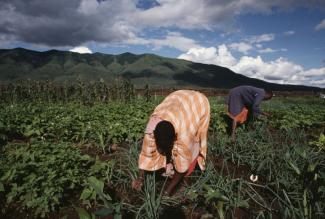Climate-smart agriculture
A complex undertaking
 Paul Harrison/Lineair Fotoarchief
Paul Harrison/Lineair Fotoarchief
In Kenya, more than 60 % of the people work in the agricultural sector, the majority as smallholders. Global warming is already causing extreme weather events – like heat waves, droughts and floods – more frequent and more intense. As a result, growing seasons and agro-ecological zones are shifting more and more. In Siaya and Kakamega, the counties under investigation in Kenya’s western highlands, the proximity of Lake Victoria is further exacerbating the effects of climate change. Farmers in both counties produce maize, sorghum, millet, meat, dairy products and tea through rain-fed agriculture. Productivity in both counties lies way below its potential.
Making matters worse, the soils are overexploited due to inadequate management and continuous use without sufficient nutrient replenishment. Soil degradation is reducing the counties’ already low agricultural productivity and threatening food security.
The situation presents a major challenge for Kenyan authorities, who are still struggling with devolution. In recent years, jurisdictions have been transferred from the national to the county authorities. However, several county authorities are not yet fully operational, and that reduces the scope for supporting sustainable development programmes.
Small farmers cannot take on soil protection and climate-change adaptation on their own. Moreover, Kenya’s agricultural extension service lacks the necessary equipment and trained staff to develop appropriate strategies.
CSA implementation in Western Kenya
The SLE study was commissioned by the German Agency for International Cooperation (GIZ) and was carried out in cooperation with GIZ Western Kenya and the International Centre for Tropical Agriculture (CIAT) in Nairobi. The team focused on three priority research areas for the implementation of climate-smart agriculture (see box):
- policies and frameworks;
- the farm-level perspective; and
- forging links between research and practical application with help from the extension service.
The study clearly showed that county governments will have to act as catalysts in order to create the necessary environment for large-scale CSA implementation. Climate-smart agriculture must be integrated into key planning processes so it can receive financial support. Another goal is “smart development”, which makes use of synergies between different authorities. Issues such as food security, health and environmental protection must be considered in context.
The study also recommends to define the term “climate-smart agriculture” in a coherent way for Kenyan usage. The international definition of CSA allows for a wide spectrum of technical alternatives. Kenya should therefore arrive at a consensus on what it will call “climate smart”. A national forum could be convened in order to allow farmers, researchers, agricultural advisory services and administrators to develop a shared concept. Emphasis should be placed on cost-effective and flexible solutions that would allow fast responses to changing environmental conditions.
The notion of mitigation is particularly interesting. If it is disregarded, climate-smart agriculture looks very much like conventional climate adaptation in practice. On the other hand, payments could encourage carbon sequestration. Schemes that provide payments for ecosystem services (PES) can be useful. Another relevant ecosystem service is enriching the soil with organic matter or planting trees.
The challenge of implementation
The challenge of implementation is tremendous, though. Kenya’s agricultural extension service has many shortcomings, so management has to improve, and more and better-trained employees need to be hired. The new staff must get appropriate pay, training and further vocational education. Improving the extension system is the task of the Ministry of Agriculture. It needs to create a stimulating environment and ensure that its teaching and training modules are up-to-date. A central platform should help to guarantee that uniform, standardised and up-to-date educational materials are used.
At the same time, a participatory approach is needed that involves farmers, the extension service and research institutions. The idea is to ensure that farmers and advisers have opportunities beyond only expressing opinions on cultivation methods. They must be empowered to contribute significantly to development.
Once the extension service is better equipped to reach and advise farmers, the latter will be in a better position to make good decisions on climate-smart agriculture. Doing so will require a thorough and appropriate transfer of information to guide farmers through the entire process. At the same time, model farms, farmer-to-farmer exchanges and other measures should ensure the information is spread.
Structural barriers
However, there are also barriers that are structural in nature. They include unfavourable market conditions, political and institutional barriers, a lack of infrastructure — including information and communications technology — and poor service quality. Comprehensive policies and impact monitoring are indispensable for a successful large-scale implementation of CSA.
Moreover, farmers have no guarantee that their farms will be sufficiently resilient against future climate changes even if they take climate-smart approaches. Additional safety nets are needed, including subsidised meteorological services, insurance against crop failure as well as income loss and measures to support farmers until they see a return on their investment.
In sum, implementing climate-smart agriculture is a complex undertaking. The advantage is that this holistic approach can build resilience among large segments of the population and improve the standard of living in rural areas.
Michaela Schaller is an independent consultant and climate expert. She was the team leader of the SLE Climate-smart Agriculture Project 2016/17 in Kenya.
michaela_schaller@web.de
Link
Overseas projects of the Centre for Rural Development:
https://www.sle-berlin.de/index.php/ap-2016